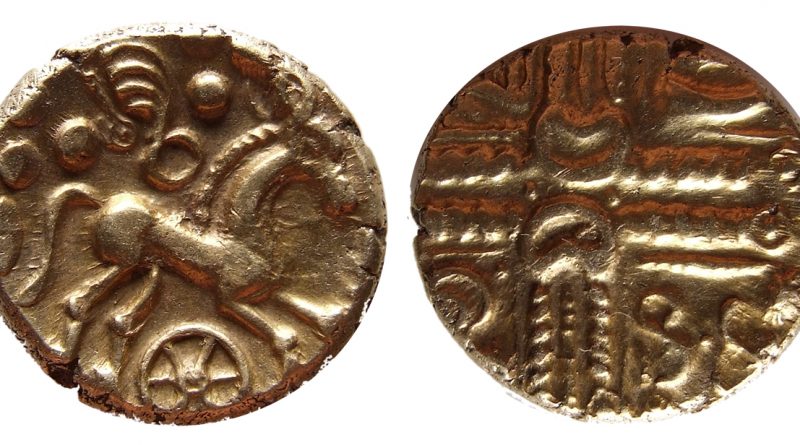Gold Stater – Catuvellauni
Agreement with landowner
Lots of detectorists have 50/50 agreements with landowners. Through these agreements the finder of a coin or artefact pays 50% of its value to the landowner and is then allowed to keep it. Occasionally, it is the opposite way round and the landowner pays the finder 50%.
Middle Whaddon Chase type
Pictured here is an Ancient British gold stater, which was unearthed by Andrew Thompson. Andrew said it came off a field that had yielded nothing but lead, shotgun cartridge caps and green waste. This stater proves that even on an unproductive field perseverance can eventually pay off in the shape of a wonderful find. On the obverse is a crossed wreath design with opposed crescents separated by two small pellets in the centre. The horse on the reverse is more like the real thing than on many other Ancient British coins and has a spoked wheel below, above it is a wing motif and a ring-and-dot flanked by two large pellets; there is another large pellet over the tail and an eye behind it. The coin was struck by the Catuvellauni and in Ancient British Coins it is listed as the Middle Whaddon Chase type. However, this coin is struck from a similar but different set of dies.
Valuation
The obverse is off centre, the horse’s head weak and there are very faint marks on both sides but the coin is otherwise in good VF condition with eye appeal. Andrew has a 50/50 agreement with the landowner, so wanted a valuation on his find. Well, it’s an attractive coin, so a likely hammer price if sold at auction would be between £750 and £900. This will provide a price range for negotiations with the landowner.
Coin Valuation Service
Have your coin or artefact valued using my free online coin valuation service

